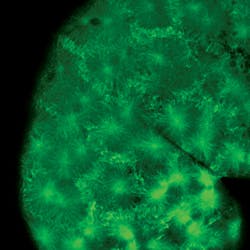MICROSCOPY/IN-VIVO CELL IMAGING: Super-resolution multifocal imaging highlights cellular detail
A hybrid approach to super-resolution microscopy called multifocal structured illumination microscopy (MSIM) has enabled researchers to see living cell structures measuring an eighth of a micrometer in size within living zebrafish larvae. The method combines the super-resolution capability of structured illumination microscopy (SIM) with the physical optical sectioning of confocal microscopy. It uses commercial off-the-shelf parts and open-source software, enabling integration with existing microscopes.1
Multifocal SIM minimizes scattered light by illuminating objects only at certain spots rather than completely. Scientists can capture a series of images at variable illumination and within a few seconds—adjusting the depth of field and imaging at various depth levels. Then, they process these images on a computer to produce a 3D view. The result is sharp, illuminated detail: The method makes possible resolutions of 145 nm in the plane and 400 nm in between.
MSIM was developed by researchers from the Karlsruhe Institute of Technology (KIT; Karlsruhe, Germany), the Max Planck Institute for Polymer Research (Mainz, Germany), and the American National Institutes of Health (NIH; Bethesda, MD).
1. A. G. York, Nat. Meth., 9, 749–754 (2012).
More BioOptics World Current Issue Articles
More BioOptics World Archives Issue Articles

